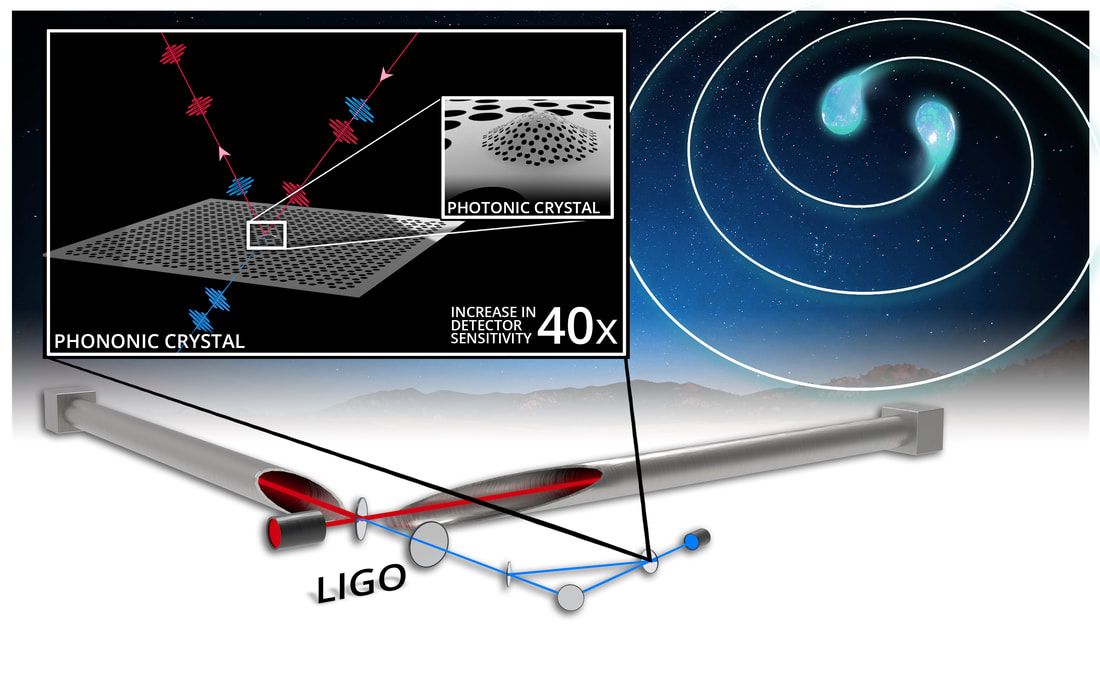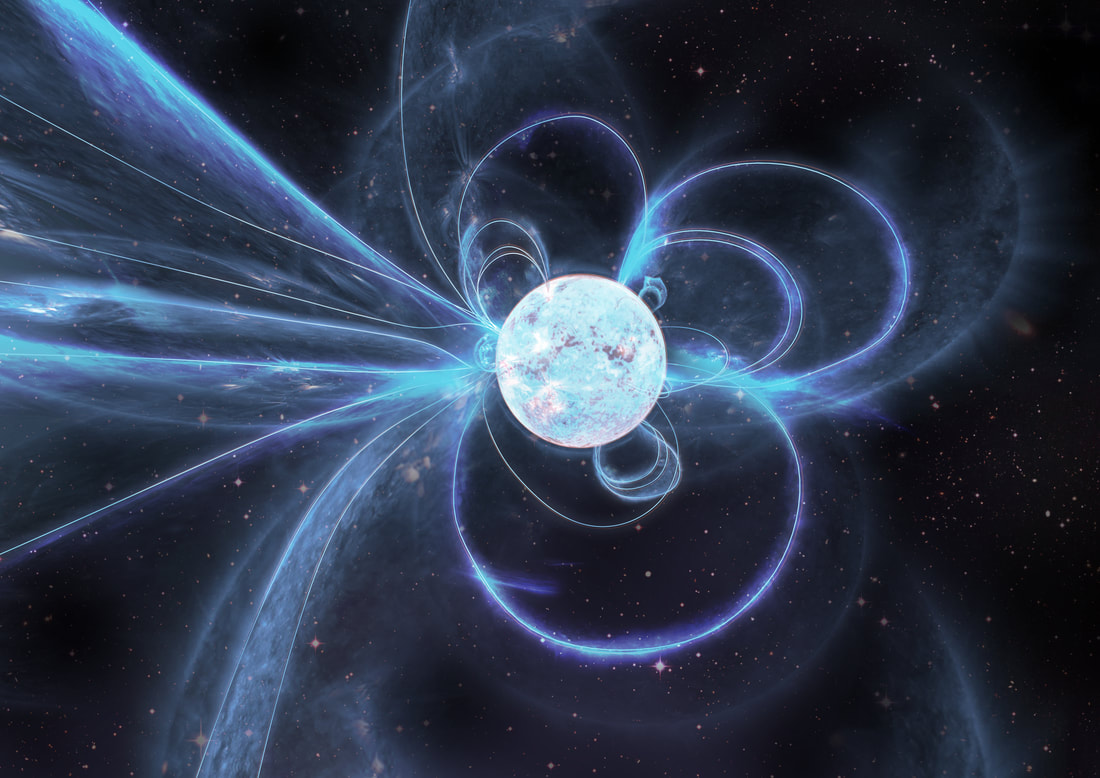 Credit: Carl Knox, ARC Centre of Excellence for Gravitational Wave Discovery, Swinburne University Credit: Carl Knox, ARC Centre of Excellence for Gravitational Wave Discovery, Swinburne University A new technology that can improve gravitational-wave detectors, one of the most sensitive instruments used by scientific researchers, has been pioneered by physicists at The University of Western Australia in collaboration with an international team of researchers. The new technology allows the world’s existing gravitational wave detectors to achieve a sensitivity that was previously thought only to be achievable by building much bigger detectors. The paper, published today in Communications Physics, was led by the ARC Centre of Excellence for Gravitational Wave Discovery (OzGrav) at UWA, in collaboration with the ARC Centre of Excellence for Engineered Quantum Systems, the Niels Bohr Institute in Copenhagen and the California Institute of Technology in Pasadena. Emeritus Professor David Blair, from UWA’s Department of Physics, said the technology merged quantum particles of sound vibration called phonons with photons of laser light, to create a new type of amplification in which the merged particles cycled back and forth billions of times without being lost. “More than a hundred years ago Einstein proved that light comes as little energy packets, which we now call photons,” Emeritus Professor Blair said. One of the most sophisticated applications of photons are gravitational-wave detectors, which allow physicists to observe ripples in space and time caused by cosmic collisions. “Two years after Einstein's prediction of photons, he proposed that heat and sound also come in energy packets, which we now call phonons,” Emeritus Professor Blair said. “Phonons are much trickier to harness individually in their quantum form because they’re usually swamped by vast numbers of random phonons called thermal background.” Emeritus Professor Blair was awarded the prestigious Prime Minister’s Prize for Science in 2020 for his contribution to the first detection of gravitational waves. Lead author Dr Michael Page said the trick was to combine phonons and photons together in such a way that a broad range of gravitational wave frequencies could be amplified simultaneously. “The new breakthrough will let physicists observe the most extreme and concentrated matter in the known universe as it collapses into a black hole, which happens when two neutron stars collide,” Dr Page said. Emeritus Professor David Blair said the waveforms sounded like a brief scream that was pitched too high for current detectors to hear. “Our technology will make those waveforms audible, and will also reveal whether the neutrons in neutron stars get split up into their constituents called quarks when they are in this extreme state” Emeritus Professor Blair said. “The most exciting thing about seeing nuclear matter turn into a black hole is that the process is like the reverse of the Big Bang that created the universe. Observing this happen will be like watching a movie of the Big Bang played backwards.” Emeritus Professor Blair said while the technology did not represent an instant solution to improving gravitational-wave detectors it offers a low-cost route to improvement. As featured on the UWA news website.
0 Comments
Astronomers have for the first time used distant galaxies as ‘scintillating pins’ to locate and identify a piece of the Milky Way’s missing matter. For decades, scientists have been puzzled as to why they couldn’t account for all the matter in the universe as predicted by theory. While most of the universe’s mass is thought to be mysterious dark matter and dark energy, 5 percent is ‘normal matter’ that makes up stars, planets, asteroids, peanut butter and butterflies. This is known as baryonic matter. However, direct measurement has only accounted for about half the expected baryonic matter. Yuanming Wang, a doctoral candidate in the School of Physics at the University of Sydney, has developed an ingenious method to help track down the missing matter. She has applied her technique to pinpoint a hitherto undetected stream of cold gas in the Milky Way about 10 light years from Earth. The cloud is about a trillion kilometres long and 10 billion kilometres wide but only weighing about the mass of our Moon. The results, published in the Monthly Notices of the Royal Astronomical Society, offer a promising way for scientists to track down the Milky Way’s missing matter. “We suspect that much of the ‘missing’ baryonic matter is in the form of cold gas clouds either in galaxies or between galaxies,” said Ms Wang, who is pursuing her PhD at the Sydney Institute for Astronomy. “This gas is undetectable using conventional methods, as it emits no visible light of its own and is just too cold for detection via radio astronomy,” she said. What the astronomers did is look for radio sources in the distant background to see how they ‘shimmered’. “We found five twinkling radio sources on a giant line in the sky. Their signals show their light must have passed through the same cold clump of gas,” Ms Wang said. Just as visible light is distorted as it passes through our atmosphere to give stars their twinkle, when radio waves pass through matter, it also affects their brightness. It was this ‘scintillation’ that Ms Wang and her colleagues detected. Dr Artem Tuntsov, a co-author from Manly Astrophysics, said: “We aren’t quite sure what the strange cloud is, but one possibility is that it could be a hydrogen ‘snow cloud’ disrupted by a nearby star to form a long, thin clump of gas.” Hydrogen freezes at about minus 260 degrees and theorists have proposed that some of the universe’s missing baryonic matter could be locked up in these hydrogen ‘snow clouds’. They are almost impossible to detect directly. “However, we have now developed a method to identify such clumps of ‘invisible’ cold gas using background galaxies as pins,” Ms Wang said. Ms Wang’s supervisor, Professor Tara Murphy, said: “This is a brilliant result for a young astronomer. We hope the methods trailblazed by Yuanming will allow us to detect more missing matter.” The data to find the gas cloud was taken using the CSIRO’s Australian Square Kilometre Array Pathfinder (ASKAP) radio telescope in Western Australia. Dr Keith Bannister, Principal Research Engineer at CSIRO, said: “It is ASKAP’s wide field of view, seeing tens of thousands of galaxies in a single observation that allowed us to measure the shape of the gas cloud.” Professor Murphy said: “This is the first time that multiple ‘scintillators’ have been detected behind the same cloud of cold gas. In the next few years, we should be able to use similar methods with ASKAP to detect a large number of such gas structures in our galaxy.” The research was done in collaboration with CSIRO, Manly Astrophysics, the University of Wisconsin-Milwaukee and the ARC Centre of Excellence for Gravitational Wave Discovery, OzGrav. Media release written and edited by The University of Sydney media office. Congratulations to OzGrav researchers Adam Deller, Ryan Shannon, Cherie Day, Stefan Oslowski, Chris Flynn, Wael Farah, on receiving the Newcomb Cleveland prize from the AAAS. The award is for the best paper published in Science Magazine in the last year and was awarded for their paper that presented the discovery of the first localised one-off FRB: 'A single fast radio burst localized to a massive galaxy at cosmological distance'.
Full media release by CSIRO here: https://www.csiro.au/en/News/News-releases/2021/In-the-blink-of-an-eye-astronomers-win-prestigious-American-science-prize A recent study by an international team of scientists—led by the Galician Institute of High Energy Physics, the University of Aveiro, and including OzGrav researchers—shows that the “heaviest black hole collision” ever observed might be something even more mysterious—dark matter. Gravitational waves are ripples in the fabric of space-time that travel at the speed of light. Predicted in Einstein’s General Theory of Relativity, they originate in the most violent events of our Universe, carrying information about their sources. Since 2015, humankind can observe and interpret gravitational waves thanks to the two Advanced LIGO detectors (Livingston and Hanford, USA) and the Advanced Virgo detector (Cascina, Italy). To date, these detectors have already observed around 50 gravitational-wave signals which originated in the coalescence and merger of two of the most mysterious entities in the Universe—black holes and neutron stars—deepening our knowledge of the Universe. Gravitational wave astronomy could eventually provide us with evidence for previously unobserved or unexpected objects and shed light on current open issues, like the nature of dark matter—a discovery that may have already happened. In September 2020, the LIGO and Virgo collaborations (LVC) announced the gravitational-wave signal called GW190521. The signal was consistent with the collision of two black holes of 85 and 66 times the mass of the Sun, which produced a final 142 solar mass black hole—this was the first-ever detected intermediate-mass black hole. This discovery was extremely important as intermediate black holes were long considered the missing link between two well-known black-hole families: the stellar-mass black holes, that form from the collapse of stars, and the supermassive black holes, that hide in the centre of almost every galaxy. Despite its significance, the observation of GW190521 posed an enormous challenge to scientists’ understanding of stellar evolution: the life and death of stars is significantly more massive than our Sun. If this is correct, the heaviest of the two colliding black holes shouldn’t have occurred as the end-result of the gravitational collapse of a massive star. In an article recently published in Physical Review Letters, a team of scientists lead by OzGrav alumnus Dr Juan Calderón Bustillo, (now “La Caixa Junior Leader - Marie Curie Fellow”, at the Galician Institute of High Energy Physics) and Dr Nicolás Sanchis-Gual, a postdoctoral researcher at the University of Aveiro and at the Instituto Superior Técnico (University of Lisbon), together with OzGrav researchers from Monash University Dr Rory Smith and Avi Vajpeyi, and collaborators from the University of Valencia and The Chinese University of Hong Kong, has proposed an alternative explanation for the origin of the signal GW190521: the collision of two exotic compact objects known as boson stars. Such hypothetical stars are among the simplest exotic compact objects proposed, and present as well-founded dark matter candidates. Within this interpretation, the team estimated the mass of a new particle constituent of these stars: an ultra-light boson with a mass billionths of times smaller than that of the electron. Dr Nicolás Sanchis-Gual, explains: “Boson stars are objects almost as compact as black holes, but they don’t have a ‘no-return’ surface, or event horizon. When they collide, they form a boson star that can become unstable, eventually collapsing to a black hole, and producing a signal consistent with what LIGO and Virgo observed. Unlike regular stars, which are made of what we commonly know as matter, boson stars are made up of what we know as ultralight bosons. These bosons are one of the most appealing candidates for constituting dark matter, which forms ~27% of the Universe.” The team compared the GW190521 signal to computer simulations of boson-star mergers and found that these explain the data slightly better than the analysis conducted by LIGO and Virgo. The result implies that the source would have different properties than stated earlier. Dr Calderón Bustillo explains: “First, we wouldn’t be talking about colliding black holes anymore, which eliminates the issue of dealing with a forbidden black hole. Second, because boson star mergers are much weaker, we infer a much closer distance than the one estimated by LIGO and Virgo. This leads to a much larger mass for the final black hole, of about 250 solar masses, so the fact that we have witnessed the formation of an intermediate-mass black hole remains true”. The team found that even though the analysis tends to favour “by design” the merging black-holes hypothesis, a boson star merger is actually preferred by the data, although in a non-conclusive way. Professor José A. Font from the University of Valencia says: “Our results show that the two scenarios are almost indistinguishable given the data, although the exotic boson-star one is slightly preferred. This is very exciting since the computational framework of our current boson-star simulations is still fairly limited and subject to major improvements. A more evolved model might lead to even larger evidence for the boson-star scenario and would also allow us to study similar gravitational-wave observations under the boson-star merger assumption”. This result would not only involve the first observation of boson stars, but also that of their building block, a new particle known as ultra-light boson. Such ultra-light bosons have been proposed as the constituents of what we know as dark matter, which makes up around 27% of the observable Universe. Professor Carlos Herdeiro, from University of Aveiro says that “one of the most fascinating results is that we can actually measure the mass of this putative new dark-matter particle, and that a value of zero is discarded with high confidence. If confirmed by subsequent analysis of this and other gravitational-wave observations, our result would provide the first observational evidence for a long-sought dark matter candidate”. OzGrav researcher Dr Rory Smith adds: “Gravitational-wave astronomy is still very much in its infancy. However, the fact that we are already able to start drawing connections between gravitational-wave observations and fundamental particle physics is a remarkable sign of how powerful this new field is. Even if future observations rule out boson stars as real astronomical objects, we should expect many new and exciting discoveries in the future”. Written by Dr Juan Calderón Bustillo. Also featured on Space Australia. In the moments immediately following the Big Bang, the very first gravitational waves rang out. The product of quantum fluctuations in the new soup of primordial matter, these earliest ripples through the fabric of space-time were quickly amplified by inflationary processes that drove the universe to explosively expand.
Primordial gravitational waves, produced nearly 13.8 billion years ago, still echo through the Universe today. But they are drowned out by the crackle of gravitational waves produced by more recent events, such as colliding black holes and neutron stars. Now a team of international scientists, including reasearchers from the Massachusetts Institute of Technology and OzGrav, has developed a method to tease out the very faint signals of primordial ripples from gravitational-wave data. Their results were published in Physical Review Letters. Gravitational waves are being detected on an almost daily basis by LIGO and other gravitational-wave detectors, but primordial gravitational signals are several orders of magnitude fainter than what these detectors can register. It’s expected that the next generation of detectors will be sensitive enough to pick up these earliest ripples. In the next decade, as more sensitive instruments come online, the new method could be applied to dig up hidden signals of the Universe’s first gravitational waves. The pattern and properties of these primordial waves could then reveal clues about the early universe, such as the conditions that drove inflation. ‘If the strength of the primordial signal is within the range of what next-generation detectors can detect, which it might be, then it would be a matter of more or less just turning the crank on the data, using this method we’ve developed,’ says Sylvia Biscoveanu—MIT graduate student and the study’s lead author. ‘These primordial gravitational waves can then tell us about processes in the early Universe that are otherwise impossible to probe.’ OzGrav researchers Colm Talbot, Eric Thrane and Rory Smith were also co-authors of the study. The hunt for primordial gravitational waves has concentrated mainly on the cosmic microwave background, or CMB, which is thought to be radiation that is leftover from the Big Bang. Scientists believe that when primordial gravitational waves rippled out, they left an imprint on the CMB, in the form of B-modes, a type of subtle polarization pattern.Physicists have looked for signs of B-modes, most famously with the BICEP Array, a series of experiments including BICEP2, which in 2014 scientists believed had detected B-modes; however, the signal turned out to be due to galactic dust. As scientists continue to look for primordial gravitational waves in the CMB, others are hunting the ripples directly in gravitational-wave data. The general idea has been to try and subtract away the ‘astrophysical foreground’—any gravitational-wave signal that arises from an astrophysical source, such as colliding black holes, neutron stars, and exploding supernovae. Only after subtracting this astrophysical foreground can physicists get an estimate of the quieter, nonastrophysical signals that may contain primordial waves. The problem with these methods, Biscoveanu says, is that the astrophysical foreground contains weaker signals that are too faint to discern and difficult to estimate in the final subtraction. In their study, the researchers used a predictive model to describe the more obvious ‘conversations’ of the astrophysical foreground. The team used this more accurate model to create simulated data of gravitational wave patterns and then characterize every astrophysical signal. Once they identified distinct, nonrandom patterns in gravitational-wave data, they were left with more random primordial gravitational-wave signals and instrumental noise specific to each detector. Applying their new methods, the team was able to fit both the foreground and the background at the same time, so the background signal didn’t get contaminated by the residual foreground. Biscoveanu says she hopes that once more sensitive, next-generation detectors come online, the new method can be used to cross-correlate and analyse data from two different detectors, to sift out the primordial signal. Then, scientists may have a useful thread they can trace back to the conditions of the early Universe. This article is an edited extract from the original article featured on MIT’s news website written by Jennifer Chu. Astronomers from the ARC Centre of Excellence for Gravitational Wave Discovery (OzGrav) and CSIRO have just observed bizarre, never-seen-before behaviour from a ‘radio-loud’ magnetar—a rare type of neutron star and one of the strongest magnets in the Universe. Their new findings, published today in the Monthly Notices of the Royal Astronomical Society (MNRAS), suggest magnetars have more complex magnetic fields than previously thought – which may challenge theories of how they are born and evolve over time. Magnetars are a rare type of rotating neutron star with some of the most powerful magnetic fields in the Universe. Astronomers have detected only thirty of these objects in and around the Milky Way—most of them detected by X-ray telescopes following a high-energy outburst. However, a handful of these magnetars have also been seen to emit radio pulses similar to pulsars—the less magnetic cousins of magnetars that produce beams of radio waves from their magnetic poles. Tracking how the pulses from these ‘radio-loud’ magnetars change over time offers a unique window into their evolution and geometry. In March 2020, a new magnetar named Swift J1818.0-1607 (J1818 for short) was discovered after it emitted a bright X-ray burst. Rapid follow-up observations detected radio pulses originating from the magnetar. Curiously, the appearance of the radio pulses from J1818 were quite different to those seen from other radio-loud magnetars. Most radio pulses from magnetars maintain a consistent brightness across a wide range of observing frequencies. However, the pulses from J1818 were much brighter at low frequencies than high frequencies – similar to what is seen in pulsars, another more common type of radio-emitting neutron star. In order to better understand how J1818 would evolve over time, a team led by scientists from the ARC Centre of Excellence for Gravitational Wave Discovery (OzGrav) observed it eight times using the CSIRO Parkes radio telescope (also known as Murriyang) between May and October 2020. During this time, they found the magnetar underwent a brief identity crisis: in May it was still emitting the unusual pulsar-like pulses that had been detected previously; however, by June it had started flickering between a bright and a weak state. This flickering behaviour reached a peak in July where they saw it flicking back and forth between emitting pulsar-like and magnetar-like radio pulses. “This bizarre behaviour has never been seen before in any other radio-loud magnetar,” explains study lead author and Swinburne University/CSIRO PhD student Marcus Lower. “It appears to have only been a short-lived phenomenon as by our next observation it had settled permanently into this new magnetar-like state.” The scientists also looked for pulse shape and brightness changes at different radio frequencies and compared their observations to a 50-year-old theoretical model. This model predicts the expected geometry of a pulsar, based on the twisting direction of its polarised light. “From our observations, we found that the magnetic axis of J1818 isn’t aligned with its rotation axis,” says Lower. “Instead, the radio-emitting magnetic pole appears to be in its southern hemisphere, located just below the equator. Most other magnetars have magnetic fields that are aligned with their spin axes or are a little ambiguous.” “This is the first time we have definitively seen a magnetar with a misaligned magnetic pole.” Remarkably, this magnetic geometry appears to be stable over most observations. This suggests any changes in the pulse profile are simply due to variations in the height the radio pulses are emitted above the neutron star surface. However, the August 1st 2020 observation stands out as a curious exception. “Our best geometric model for this date suggests that the radio beam briefly flipped over to a completely different magnetic pole located in the northern hemisphere of the magnetar,” says Lower. A distinct lack of any changes in the magnetar’s pulse profile shape indicate the same magnetic field lines that trigger the ‘normal’ radio pulses must also be responsible for the pulses seen from the other magnetic pole. The study suggests this is evidence that the radio pulses from J1818 originate from loops of magnetic field lines connecting two closely spaced poles, like those seen connecting the two poles of a horseshoe magnet or sunspots on the Sun. This is unlike most ordinary neutron stars which are expected to have north and south poles on opposite sides of the star that are connected by a donut-shaped magnetic field. This peculiar magnetic field configuration is also supported by an independent study of the X-rays pulses from J1818 that were detected by the NICER telescope on board the International Space Station. The X-rays appear to come from either a single distorted region of magnetic field lines that emerge from the magnetar surface or two smaller, but closely spaced, regions. These discoveries have potential implications for computer simulations of how magnetars are born and evolve over long periods of time, as more complex magnetic field geometries will change how quickly their magnetic fields are expected to decay over time. Additionally, theories that suggest fast radio bursts can originate from magnetars will have to account for radio pulses potentially originating from multiple active sites within their magnetic fields. Catching a flip between magnetic poles in action could also afford the first opportunity to map the magnetic field of a magnetar. "The Parkes telescope will be watching the magnetar closely over the next year" says scientist and study co-author Simon Johnston, from the CSIRO Astronomy and Space Science. |
|
- Home
- About
-
Our People
- Chief Investigators
- Partner Investigators
- Associate Investigators
- Postdocs and Students >
- Professional & Outreach staff
- Governance Advisory Committee
- Scientific Advisory Committee
- Executive Committee
- Equity & Diversity Committee
- Early Career Researcher Committee
- Professional Development Committee
- Research Translation Committee
- OzGrav Alumni
- Research Themes
- Education and Outreach
- Events
- News/Media
- Contact Us
- Home
- About
-
Our People
- Chief Investigators
- Partner Investigators
- Associate Investigators
- Postdocs and Students >
- Professional & Outreach staff
- Governance Advisory Committee
- Scientific Advisory Committee
- Executive Committee
- Equity & Diversity Committee
- Early Career Researcher Committee
- Professional Development Committee
- Research Translation Committee
- OzGrav Alumni
- Research Themes
- Education and Outreach
- Events
- News/Media
- Contact Us





 RSS Feed
RSS Feed








